
Castle Howard is a stately home in North Yorkshire, England, within the civil parish of Henderskelfe, located 15 miles (24 km) north of York. It is a private residence and has been the home of the Carlisle branch of the Howard family for more than 300 years. Castle Howard is not a fortified structure, but the term "castle" is sometimes used in the name of an English country house that was built on the site of a former castle.
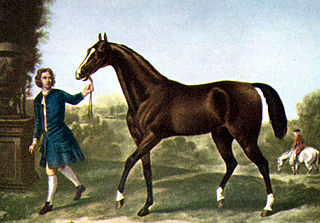
The Darley Arabian was one of three dominant foundation sires of modern Thoroughbred horse racing bloodstock. The other two founders were the Godolphin Arabian and the Byerley Turk. This bay Arabian horse was bought in Aleppo, Syria, by Thomas Darley in 1704 and shipped to Aldby Park in England, as a present for his brother.

Baron Middleton, of Middleton in the County of Warwick, is a title in the Peerage of Great Britain, created in December 1711 for Sir Thomas Willoughby, 2nd Baronet, who had previously represented Nottinghamshire and Newark in Parliament. It was one of twelve new peerages created together and known as Harley's Dozen, to give a Tory majority in the House of Lords.
Earl of Bradford is a title that has been created twice, once in the Peerage of England and once in the Peerage of the United Kingdom. It was first created in 1694 for Francis Newport, 2nd Baron Newport. However, all the Newport titles became extinct on the death of the fourth Earl in 1762. The earldom was revived in 1815 for Orlando Bridgeman, 2nd Baron Bradford. The Bridgeman family had previously succeeded to the Newport estates. The title of the peerage refers to the ancient hundred of Bradford in Shropshire, and not, as might be assumed, to the city of Bradford, Yorkshire, or the town of Bradford-on-Avon in Wiltshire.

Thomas Darley served as Her Majesty's Consul to the Levant (Syria) during the reign of Queen Anne. He is famous for having bought an Arabian colt that became an important part of the history of the Thoroughbred breed.

Allerton Castle, also known as Allerton Park, is a Grade I listed nineteenth-century Gothic or Victorian Gothic house at Allerton Mauleverer in North Yorkshire, England. It was rebuilt by architect George Martin, of Baker Street, London in 1843–53.

Sand Hutton is a village and civil parish which forms the larger part of the Claxton and Sand Hutton grouped parish council, in North Yorkshire, England, about 6 miles (9.7 km) north-east of York.

Buttercrambe is a small village in the Buttercrambe with Bossall civil parish, in North Yorkshire, England. Buttercrambe is some 9 miles (14 km) north-east of York, and on average about 56 feet (17 m) above sea level. The settlement is mentioned in the Domesday Book, and the name derives from the Old English of butere and crambe. Crambe is a word meaning bend, and so Buttercrambe's literal translation is rich piece of land in the bend of the river (Derwent).

Offchurch Bury is a manor house one mile north-west of the centre of the village of Offchurch, Warwickshire, England. It is supposed to represent the site of a palace of the Anglo-Saxon King Offa of Mercia (d.796), after which Offchurch is named, "bury" being a corruption of "burh" meaning a fortified place. William Dugdale in his Antiquities of Warwickshire (1656) stated concerning the manor of Offchurch:
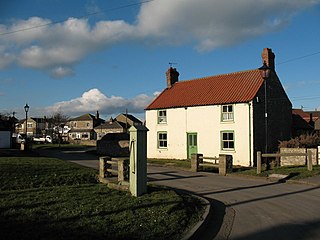
Snape is a large village in the civil parish of Snape with Thorp in the former Hambleton District of North Yorkshire, England, located about 3 miles (5 km) south of Bedale and 3 miles (5 km) west of the A1(M) motorway, it has a population of 350. Nearby is Thorp Perrow Arboretum. The name is Old Norse for a boggy tract of uncultivated land.

Wolterton Hall, is a large country house in the ecclesiastical parish of Wickmere with Wolterton and the civil parish of Wickmere in the county of Norfolk, England, United Kingdom. The present hall was commissioned by the 1st Baron Walpole of Wolterton and completed in 1742, it was designed by the architect Thomas Ripley who was a protégé of Lord Walpole and his brother Sir Robert Walpole.
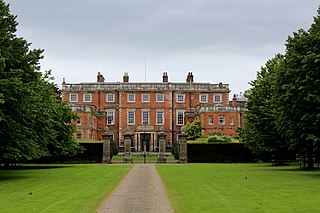
Newby Hall is a country house beside the River Ure in the parish of Skelton-on-Ure in North Yorkshire, England. It is 3 miles (4.8 km) south-east of Ripon and 6 miles (9.7 km) south of Topcliffe Castle, by which the manor of Newby was originally held. A Grade I listed building, the hall contains a collection of furniture and paintings and is surrounded by extensive gardens. Newby Hall is open to the public.
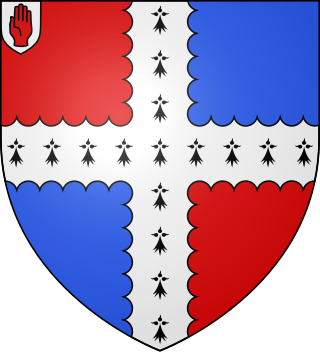
The Berney Baronetcy, of Park Hall in Reedham in the County of Norfolk, is a title in the Baronetage of England. It was created on 5 May 1620 for Richard Berney, Sheriff of Norfolk in 1622.

Groby Old Hall is partly a 15th-century brick-built manor house and grade II* listed building located very near the site of Groby Castle in the village of Groby in Leicestershire.
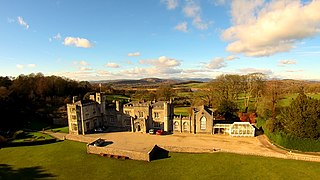
Leighton Hall is a historic house 0.5 miles (1 km) to the west of Yealand Conyers, Lancashire, England. It is recorded in the National Heritage List for England as a designated Grade II* listed building.
The Vernon family was a wealthy, prolific and widespread English family with 11th-century origins in Vernon, Normandy, France. Their extant titles include Baron Vernon and Vernon baronets of Shotwick Park.

Goldsborough Hall is a Jacobean stately home located in the village of Goldsborough, North Yorkshire, England. It is a member of the Historic Houses Association. The house itself is a Grade II* listed building. The Hall was built for Sir Richard Hutton (1560–1639) after he acquired the Goldsborough Estate in 1598, and in the 20th century it was home to Princess Mary, Countess of Harewood as her first family home.

Grantley Hall is an English country house located in North Yorkshire, England. It is situated near Grantley, about 5 miles (8 km) to the west of Ripon, on the banks of the River Skell. It is listed Grade II* on the National Heritage List for England, and the Japanese garden at the hall is listed Grade II on the Register of Historic Parks and Gardens.

Cowick Hall is a 17th-century Georgian country house in the town of Snaith, located between the villages of East and West Cowick, in the East Riding of Yorkshire, England. The house is Grade I listed and several outbuildings on the estate are Grade II listed. Once home to the Viscounts Downe, today it serves as the corporate headquarters of chemical company Croda International.
Buttercrambe with Bossall is a civil parish in the former Ryedale district of North Yorkshire, England. It contains 13 listed buildings that are recorded in the National Heritage List for England. Of these, one is listed at Grade I, the highest of the three grades, two are at Grade II*, the middle grade, and the others are at Grade II, the lowest grade. The parish contains the village of Buttercrambe, the hamlet of Bossall, and the surrounding countryside. The listed buildings include a country house and associated structures, smaller houses, two churches, a former watermill, a bridge, a farmhouse, and a group of barns.
















